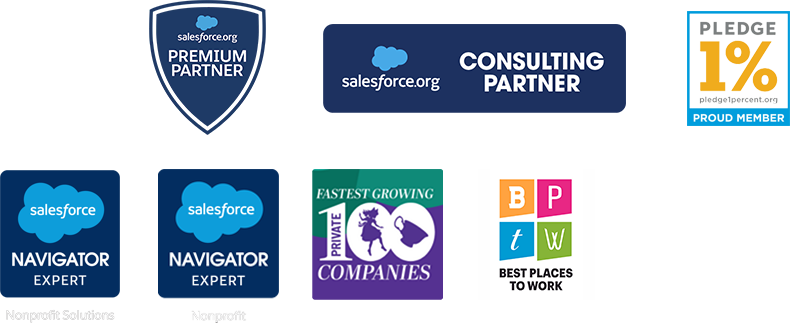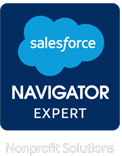6 Practical Ways Nonprofits Are Using AI Right Now
Artificial intelligence is reshaping how nonprofits operate—from analyzing data and automating routine tasks to expanding how organizations connect with the communities they serve. But while the potential is considerable, many teams are still in the early stages of understanding what AI can actually do for them. In our experience working with clients, nonprofits have the most success when they start with clear, mission-aligned use cases. When approached strategically, AI can make daily work easier, faster, and more impactful.
The question isn’t whether nonprofits should explore AI—it’s where to begin. Below are some of the most promising, real-world applications we’re seeing right now across the nonprofit sector.
Top nonprofit AI use cases that deliver impact now
1) AI-powered fundraising intelligence
Nonprofits are increasingly using AI to transform how they understand and engage donors. Intelligent tools can analyze data from systems like Salesforce and other fundraising platforms to identify giving patterns, predict donor upgrades, and automate back-office tasks such as acknowledgment letters or pledge reminders. By surfacing insights that once took hours of manual work, AI helps fundraisers focus on strategy and relationships—building deeper connections, improving retention, and raising more support without losing the human touch that drives philanthropy.
2) Program triage & crisis support (AI-assisted, human-in-the-loop)
Crisis Text Line has used machine learning to prioritize high-risk texters faster, identifying most high-risk users in the first messages so counselors can intervene sooner. The broader lesson: AI can route cases and surface risk signals while humans stay firmly in charge.
3) Monitoring & forecasting for field programs
The World Food Programme’s HungerMap blends near-real-time data with ML models to nowcast and forecast food insecurity, informing targeting and response planning across 90+ countries. This is a pattern for other issue areas: combine your operating data with open data, then use ML for early warning and smarter allocation.
4) Personalized engagement and support at scale
AI is helping nonprofits deepen relationships and reach more people—especially when staff capacity is limited. Tools like UNICEF’s U-Report platform use messaging and AI assistants to engage young people through channels they already use, from SMS to WhatsApp, even providing mental-health support through chatbots. More broadly, nonprofits are adopting AI to personalize outreach, tailor communications, and sustain meaningful engagement across audiences. The result is scaled connection without sacrificing the empathy and responsiveness that define mission-driven work.
5) Smarter Mentorship Matching with AI Agents
Big Brothers Big Sisters of America is using Salesforce’s Agentforce to help matching specialists find the right mentor for each child faster and more effectively. The system analyzes data from its Matchforce platform—considering factors like geography, interests, and life experience—to recommend pairings that are more likely to last. With Agentforce, BBBSA expects to cut the time it takes to make a match in half and increase the longevity of mentoring relationships, all while allowing staff to spend more time supporting mentors and families. This use of AI shows how intelligent agents can enhance relational work without replacing the human connection that defines it.
6) AI-Driven Environmental Advocacy and Research
The Tahoe Lead Removal Project used Claude, Anthropic’s AI assistant, to analyze decades of technical and regulatory documentation about abandoned lead cables in Lake Tahoe. By synthesizing complex engineering reports, legal filings, and environmental data, the team built a fact-based case that persuaded AT&T to remove six miles of toxic cable—achieving a 75% cost savings compared to traditional methods. Claude helped the group transform dense technical data into accessible public materials and regulatory filings, showing how community-led, AI-powered research can drive real environmental change.
Reality check: Many orgs are still early. In TechSoup’s 2025 benchmark, 76% of nonprofits reported no AI strategy, 30% cited budget as a barrier, and only 6% felt like AI experts—so if you feel behind, you’re in good company.
From Curiosity to Action
The nonprofits leading in AI today aren’t necessarily the biggest or most resourced, they’re the ones willing to experiment. These use cases show that AI’s value lies in practical, everyday improvements: saving time on research, identifying needs faster, communicating more personally, and amplifying human expertise.
Most organizations are still early in their journey, but that’s the opportunity. Starting small—with a focused pilot or a single workflow—lets nonprofits learn safely, measure impact, and build confidence. As the technology becomes more accessible, AI won’t replace the human side of the sector; it will make it stronger, freeing people to spend more time where it matters most: with their mission and their communities.
Click the link below to learn more about how nonprofits are successfuly securing funding for AI projects, including our 90-day AI Pilot Roadmap.















